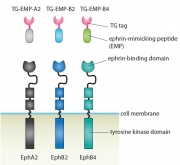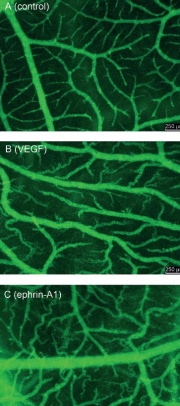|
| In vitro and in vivo angiogenesis | ||
Understandingthe formation of new blood vessels represents an important challenge for the development of therapeutics targeting revascularization of ischemic tissues or chronic wounds and for engineered tissue grafts. One important class of growth factor that participates in the regulation of angiogenesis are Eph (erythropoietin-producing human hepatocellular carcinoma) receptors and their ephrin ligands. They have been shown to participate in the regulation of cell migration, tissue boundary formation, axon guidance and angiogenesis. In order to study blood vessel formation, we developed three synthetic ephrin-mimetic-peptides (EMPs) linked to a transglutaminase (TG) tag, that can be incorporated into polyethylene glycol (PEG) gels by FXIII crosslinking. Using this technology, we seek to understand the roles of ephrins on endothelial cell migration by using 2D and 3D patterning methods. To further investigate the roles of ephrins and their influence on VEGF-induced angiogenesis, we are currently using the ex ovo chicken chorioallantoic (CAM) assay for live imaging and corrosion casting. This model allows us to get an insight on how ephrins and VEGF influence blood vessel morphology and density. It also represents an interesting intermediate model between in vitro and in vivo angiogenesis. Dr. Martin Ehrbar Stéphanie Metzger Fundings   Collaborators Prof. Jeffrey Hubbell, EPFL Prof. Valentin Djonov, University of Bern Dr. Ruslan Hlushchuk, University of Bern Publications: Weber W, Marty RR, Link N, Ehrbar M, Keller B, Weber CC, Zisch AH, Heinzen C, Djonov V, Fussenegger M., Conditional human VEGF-mediated vascularization in chicken embryos using a novel temperature-inducible gene regulation (TIGR) system., Nucleic Acids Res. , (2003), 31 Zisch AH, Lutolf MP, Ehrbar M, Raeber GP, Rizzi SC, Davies N, Schmökel H, Bezuidenhout D, Djonov V, Zilla P, Hubbell JA., Cell-demanded release of VEGF from synthetic, biointeractive cell ingrowth matrices for vascularized tissue growth., FASEB J., (2003), 2260-2 Hlushchuk R, Ehrbar M, Reichmuth P, Heinimann N, Styp-Rekowska B, Escher R, Baum O, Lienemann P, Makanya A, Keshet E, Djonov V, Decrease in VEGF expression induces intussusceptive vascular pruning., Arterioscler Thromb Vasc Biol., (2011), 2836-44 Müller K, Engesser R, Metzger S, Schulz S, Kämpf MM, Busacker M, Steinberg T, Tomakidi P, Ehrbar M, Nagy F, Timmer J, Zubriggen MD, Weber W., A red/far-red light-responsive bi-stable toggle switch to control gene expression in mammalian cells., Nucleic Acids Research, (2013), |
 Figure 1  Figure 2 |
|








